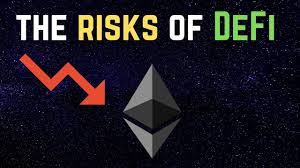Risks of Decentralized Finance

Decentralized finance is a constantly growing market, which has reported higher interest rates and yields than the traditional financial sector. This has seduced many Cryptocurrency users, who are betting on the DeFi Development market to take advantage of new investment opportunities. However, it is important to keep in mind that DeFi applications are still maturing and that there are risks inherent to their use that must be taken into account before participating in this market.
Technical vulnerabilities, errors of use and sudden movements in the market are some of the elements that alert specialists in the sector, and that every user should be aware of before depositing cryptocurrencies in any of these protocols. Although it is also good to know some other risks you face.
– Favorite target of hackers: DeFi Development Services applications can manage a lot, a lot, of money in their smart contracts. This makes them a target of interest to cybercriminals, who are on the trail of businesses vulnerable to inadvertent attacks. If a platform is released without auditing, with poor security or programming issues, it could experience massive token theft, as has happened with projects like Origin Dollar, Lendf.me, and Harvest.
– Inadvertent or intentional encoding error: As stated above, decentralized finance applications rely heavily on the codes that make them up. Smart contracts make it possible to execute vital operations for these platforms, such as money transfer, token custody or credit settlement. An error in coding a smart contract could lock up customer tokens with no possible solutions. Also, malicious entities that make life in the ecosystem could use their contracts and the inexperience of users, to get hold of money from their customers without them noticing.
-Frauds: Due to the explosion in popularity of DeFi, phishing attacks (identity theft) or fraudulent platforms that seek to replace the original ones have also increased. Whether it's downloading a malicious app, launching a fictitious token, or sending virus emails capable of stealing personal information, users in the ecosystem need to be alert to potential sources of theft or phishing.
– Errors of use: One of the characteristics that most concerns users of decentralized networks is that, due to the elimination of intermediaries, the responsibility for the service is transferred to the users. Each individual who uses blockchain platforms is in charge of managing and safeguarding their funds, since no one else has access to them. If users do not take the necessary measures to secure their finances or do not have sufficient knowledge to manipulate these assets, it may happen that they lose access to their wallets, transfer their money improperly or do not operate one of these financial services correctly. Any of these simple mistakes could result in catastrophic loss for the user,
– Insider trading: And to understand how important the management of information and knowledge is in the DeFi market, one must also know that this ecosystem is vulnerable to a practice known as “insider trading” or “trading from within”. This term is used to designate the improper use of privileged information when investing in a market, giving an individual an advantage over others, since said data is not publicly accessible. Insider trading is a risk that all markets that are just being formed run, since many creators and employees of these businesses tend to use information that they have access to due to their privileged position to make profitable investments. In this sense, a person who practices insider trading could deposit their money in an application hours before it notifies the launch of a new token, an interest rate or an alliance that makes their assets appreciate. While the rest of the community enters this opportunity late, the privileged would have already been profiting hours before thanks to the fact that they had the information ahead of time.
– Accumulation of interoperability vulnerabilities: The DeFi Development market is considered one of the riskiest in the Cryptocurrency community due to its volatility and accumulation of financial risks. Due to the fact that it is an interoperable ecosystem, with high composability capabilities, the operation of many of its applications depends on other tools with which it interconnects. If one of these services stops working properly, a domino effect can occur that affects other applications as well. For example, if something goes wrong with the MakerDAO protocol, lending platforms, decentralized exchanges, and liquidity pools could also be affected by the issue, since Maker underlies many of them. This is a feature that users must take into account when managing money in this ecosystem.
Conclusion: Cryptocurrencies have brought about a change in the functioning of money, as we knew it. It goes from the need for trusted third parties that determine the prices and what can be done with the money to a decentralized system where the community determines the price and can do what it wants with the money.
DeFi now proposes to take this one step further and bring the different elements of the conventional banking system into a fully digital and decentralized environment. They seek to offer disruptive solutions that simplify traditional banking processes. All this eliminating the need for trusted third parties, eliminating the additional costs of the conventional banking system, reducing management times and reducing tedious bureaucracy.